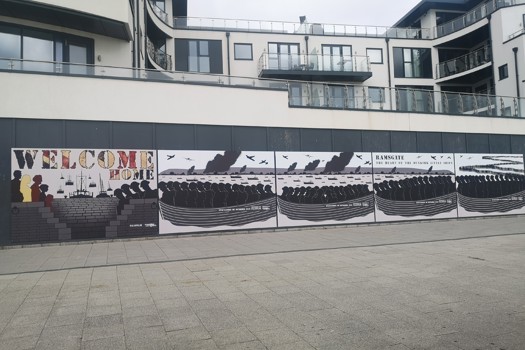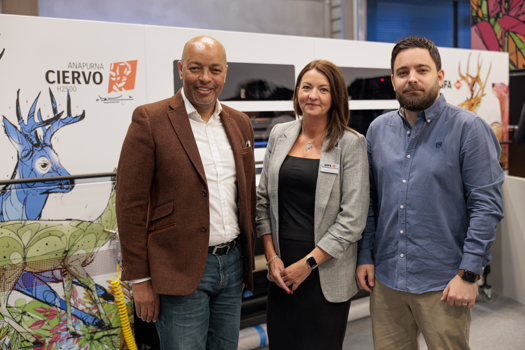What does the machine do?
It’s a B1-format sheet folder, the new top model in a family that was originally launched in 2004. This latest 82-P version sees a throughput improvement of up to 50% thanks to a new shingling feed and transport system. It’s a modular system, with two main versions: the TH buckle folder and the KH combination folder. The P stands for ‘enhanced performance, productivity, and reliability’.
According to Heidelberg UK’s commercial post-press manager Ian Trengrouse, “it revolutionises the world of folding flat sheets into folded sections. The idea is simple yet ground-breaking at the same time. It increases productivity from 50% to possibly 100% and more, with absolutely no compromise in quality.”
When was it launched and what market is it aimed at?
Both the TH 82-P and KH 82-P were seen for the first time at Drupa 2016.
According to Trengrouse the target market is “anyone who folds up to B1 sheets, from high-production print shops looking at 100,000-plus per shift, to the jobbing commercial printer who wants a highly efficient folding machine.” He points out that the capacity increase means that one 82-P could replace two older folders if needed – Buxton Press, for example, replaced four folders with two new 82-P models at the end of last year.
How does it work?
The PFX feeder that supports the new shingling system was originally launched at Drupa 2012 on the wider Stahlfolder TX 96. To cope with the increased throughput the 82-P has a Palamides alpha 500 hd delivery with one-person operation (alternatively a horizontal log stacker can be used). A new optional pressing module can also be specified, to produce a sharper fold.
The shingle system works by underlapping single sheets from the pallet into the infeed (similar to a printing press) and overlapping sheets in the subsequent second and third folding stations. This reduces the ‘pitch’ between sheets so increases individual sheet throughput.
Trengrouse says: “By not having a gap between each sheet, we can increase the number of sheets within the body of the machine without increasing mechanical speed. The folding angle of the buckle plate is now reduced, so much so that we create the fold with a knife integrated into the buckle plate. It sounds complicated, but in reality it is simple yet effective and gives a high-quality, accurate fold, especially on second and third folds.”
All versions have touchscreen controls and can connect to a Prinect workflow system via Heidelberg’s Postpress Manager.
How fast is it?
As with any folder, it depends on how many folds you need. Trengrouse says: “If we set the machine at 140m/min on an SRA1 sheet, folding a 16pp A4 section, with the previous system’s infeed gap of 4cm, we produce 9,100cph. With the shingling function activated, the same mechanical speed will yield 16,000cph. This is the ‘wow’ moment for customers. When we switch to shingling everyone in front of the machine simply says ‘wow’, followed by ‘how do you do that?’ The same goes for any other type of section, so a 32pp A5 will fold at 15,000cph.”
What is the USP?
It’s the throughput increase, says Trengrouse. “Paper can only be pushed so much before it starts to deteriorate. We have looked at higher mechanical speed solutions before and it does work to a point, but on low stock weights, such as 70gsm, and cross-folds, which are needed to produce sections, pure speed is not the answer. We slowed down to speed up.”
How easy is it to use?
“It is as simple to use as any folder on the market,” says Trengrouse. “The level of automation can be tailored to suit, from a totally manual machine, to a fully automated machine, or anything in between.
“The makeready speed is the same as the production speed, so the operator will set the machine as normal, start running, activate the shingling function via the touchscreen and that’s it, 9,100 to 16,000cph at the touch of a button.”
What training and support is on offer?
“Training is tailored to the customers’ needs, dependent on numbers and skill level. Full Heidelberg service support backs up the machines,” says Trengrouse.
How much does it cost?
Heidelberg is a bit shy about precise prices, but says the Stahlfolder 82 family prices range from £70,000 to £300,000 depending on specification.
How many are installed currently?
Heidelberg has sold more than 50 82-P machines worldwide, with 11 in the UK.
SPECIFICATIONS
Max sheet width 820mm
Max sheet length 1,125mm
Max fold length 630mm
Min fold length 60mm (combination), 150mm (buckle)
Paper weights 70–250gsm
Max pile height 1,200mm
Max speed 250m/min
Price From £70,000 to £300,000
Contact Heidelberg UK 020 8490 3500 www.heidelberg.com
ALTERNATIVES
MBO K8 RS
There are few machines in the performance class of the new Stahlfolder. Other B1 folders such as the Shoei SPK82, Horizon AFC-746F and lower-end Heidelberg and MBOs can’t hit the same throughput. Stuart Bamford, sales manager of post-press and packaging at MBO’s distributor Friedheim International, says that the K8 RS model can keep up with the 18,000sph of the latest sheetfed presses, which even the Stahlfolder 82-P can’t. The K8 RS is based on the standard K8 Perfection with the additional modified suction head, Vaculift RS, double Vacubel and a more powerful drive motor.
Speed 275m/min
Max sheet width 780mm
Max sheet length 1,200mm
Minimum folding length 60mm
Number of buckle plates 4-6
Price From £200,000-£300,000
Contact Friedheim 01442 206100 www.friedheim.co.uk
USER REVIEW
“In one 11.5-hour day shift the TH 82-P produced 150,000 sections. This was for a long run job but even with changeovers the productivity of this folder is very, very impressive” 4/5
Andrew Jones Managing director, Stephens & George










